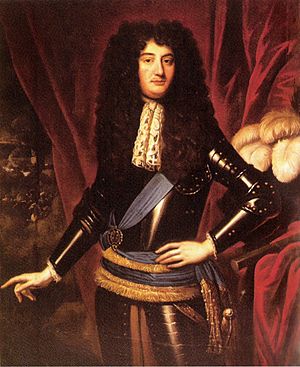Convention of Estates (1689) facts for kids

The 1689 Convention of Estates was a special meeting held in Scotland from March to June 1689. Its main goal was to decide who should be the next king or queen of Scotland. This happened after King James VII of Scotland (who was also James II of England) lost his throne in what was called the Glorious Revolution in 1688.
The Convention of Estates was like a special version of the Scottish Parliament. It included three main groups: church leaders (bishops), nobles (barons), and representatives from towns (burghs). Usually, these meetings were only called by the king to raise taxes. But this time, it was different. Unlike a similar meeting in England, the Scottish Convention also had to decide who would control the Church of Scotland, often called the Kirk.
Contents
Why Was the Convention Needed?
Even though Scotland wasn't directly involved in the Glorious Revolution in England, most people in Scotland didn't support King James anymore by late 1688. Many Scottish advisors who were living in exile, like Melville and Argyll, were working with William of Orange.
When news spread that King James had fled, people celebrated in Edinburgh and Glasgow. There were even some protests against Catholics. On January 7, 1689, the Scottish Privy Council (a group of royal advisors) asked William to take charge of the government. They wanted him to do this until the Convention could meet and decide on a new plan for Scotland.
Choosing a New King and Queen
In February 1689, a similar meeting in England decided that William of Orange and his wife, Mary, would be the new joint rulers of England.
Elections for the Scottish Convention were held in March 1689. A "Convention" was just like a Parliament, but it focused on specific issues. The last one had been in 1678 to approve taxes. Out of 125 people elected to the Convention, 75 were Presbyterians and 50 were Episcopalians. This meant the meeting would not only decide on the king but also on the future of the Church of Scotland.
Big Decisions and Challenges

William's choice for the leader of the Convention, the 3rd Duke of Hamilton, was elected. However, the Duke's own son remained loyal to King James. Even though the Episcopalians were a smaller group, they hoped to keep bishops in the Church of Scotland because William supported them.
But then, on March 12, King James landed in Ireland to try and get his throne back. On March 16, a letter from James was read to the Convention. In it, he demanded that they obey him and threatened them if they didn't.
This letter made many people angry. Some Episcopalians stopped attending the Convention, saying they feared for their safety. Others changed their minds and joined the Presbyterian side. Tensions were very high. The Duke of Gordon was holding Edinburgh Castle for King James, and Viscount Dundee was gathering an army in the Highlands. Because of this, the Presbyterian group became even stronger in the Convention, which met secretly with its own guards.
The Claim of Right
In England, Parliament said King James had "abandoned" his throne by running away to France. This argument didn't quite work for Scotland. So, the Scottish Convention decided that James had "forfeited" his throne because of his actions. These actions were listed in a document called the Articles of Grievances.
This was a huge change! If Parliament could decide that a king had lost his throne, it meant that kings got their power from Parliament, not directly from God. This ended the idea of the Divine Right of Kings, which said kings were chosen by God.
The Convention offered the Scottish throne to Mary and William. William was given royal power because he already held the throne "de facto" (in reality), almost like he had won it. The Scottish bishops tried to suggest that Scotland should unite with England to keep bishops in the church, but the English Parliament said no.
On April 11, the Convention officially ended James's reign. They also approved the Articles of Grievances and the Claim of Right Act. This made the Scottish Parliament the main law-making power in Scotland.
After the Convention
On May 11, 1689, William and Mary accepted the Scottish throne. The Convention then officially became a full Parliament on June 5.
The Jacobite Rising of 1689 (a rebellion by those who supported King James) showed that the new government needed the support of the Presbyterians. This led to bishops being completely removed from the Kirk in 1690. This decision left a big part of the Scottish political class feeling left out. In the 1700s, these Episcopalians who didn't accept the new rulers became a key group supporting the Jacobite movement to bring James's family back to the throne.
King James and his supporters, called Jacobites, believed the Convention was "illegal." They argued that the Convention didn't have the power to remove a king because its authority was only for raising taxes, and it hadn't even been called by the rightful king.
Sources

